
|   |

|   |
 e-mail: sunilkothari1933@gmail.com Parva: Celebrating 25 years of Abhinava Dance Company Photos courtesy: ADC March 5, 2020 Kathak dancers Nirupama and Rajendra, the husband and wife team are well known and have been active on the scene for more than 25 years. They celebrated silver jubilee of their institution for two days on 14th and 15th February at Chowdiah Hall, Bangalore. 
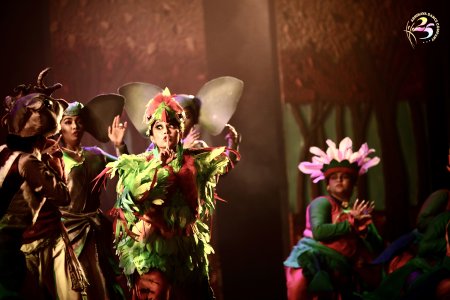
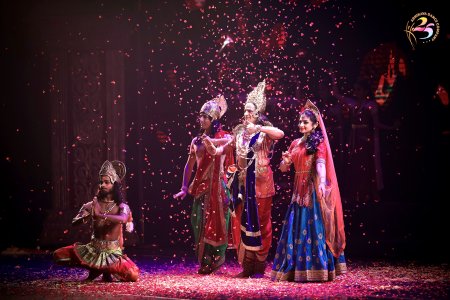
Rama Katha Vismaya It was indeed a grand affair. On the first evening was the presentation of their mega production Rama Katha Vismaya a la Disneyland, as Shatavadhani Dr. R Ganesh, the celebrated scholar and guiding force behind the institution, described it and as it is seen through the eyes of child Krishna whom mother Yashoda tells a story to put him to sleep. An interesting shloka from Krishna Karnamritam, Rama namo babhuvaha, there was a King called Rama, forms the peg on which the story of Ramayana with select sequences is woven, with pomp and spectacular props, screening of palaces and forests, river and mountains. From the word go the audience is taken on a roller coaster ride in a seamless manner. In one corner of the stage are seen Krishna and Yashoda engaged in conversation when to please him Yashoda starts telling the story of Rama. People of Ayodhya are seen decorating the doors, houses, floors. A joyous atmosphere prevails. From the large crowd, prop up Rama, Lakshmana, Bharata and Shatrughna. Then appear rishis being scared of demons that are destroying their yagnavedis. Rama and Lakshmana are practicing archery, along with a series of young archers. Vishwamitra beckons to Rama and Lakshmana to accompany him and protect the rishis who are performing Yagna. Like children who would imagine how demons would look, with strange head gears, horns, protruding teeth and bloated tummies, two demons dance, jump around, scare the rishis who run hither thither, frightened. Rama and Lakshmana vanquish the demons and with Vishwamitra proceed to Mithila where Sita’s swayamvara is organized. The mighty bow of Lord Shiva is lifted by Rama and they are married. Skipping over many events which the audience know, we are entertained at Dandakaranya when the trees, creepers, flowers, butterflies, parrots, peacocks, animals, elephants receive Rama, Lakshmana and Sita, and arrange a welcome party for them. It is one of the finest sequences followed by Shurpanakha’s arrival. A bad feeling pervades the forest and a parrot comes and warns all that something terrible is coming. Shurpanakha arrives with her demonic form but realizing that she wants to entice Rama, she disguises as a beautiful maiden. Slipping involuntarily into demonic manners, Shurpanakha regains her beautiful form. Shurpanakha’s role is enacted by Nirupama with lot of humour. Singing ‘O Rama’ and when pushed to Lakshmana also singing in same tune, ‘O Lakshmana O Lakshmana’ she caricatures herself and generates mirth. Lakshmana chops off her nose and she wearing mask runs crying to Ravana. Similarly appearance of Ravana, but keeping both Ravana in original form and in form of Sadhu asking for alms, is an interesting device. Ravana’s appearance with ten heads and dancers holding masks individually creates illusion. These episodes are imaginatively choreographed. For child Krishna when he listens to cries of Rama calling Lakshmana, he jumps saying, ‘Saumitra Saumitra’ and mother Yashoda is surprised to see Krishna acting like that and wielding a bow. The suggestion that he is an incarnation of Rama is shown suggestively. The unfolding is done in such quicksilver manner that the audience remains glued to their seats. The impact of the presentation was powerful. The music was another element which lifted the production to artistic heights. 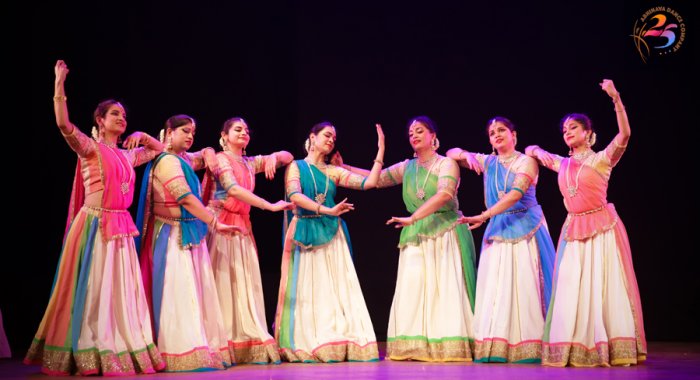 Abhinava Kathak ensemble On second evening, Kathak guru Birju Maharaj was to perform along with Padma Subrahmanyam. Unfortunately as he was unwell, he could not come. However, he sent a message that he would perform for the rasikas when he is well. Therefore, Nirupama and Rajendra presented their traditional Kathak reciting Padhant and performing an item titled Tarang with its intricacies and beauty of Lucknow gharana. Trained by legendary Maya Rao they have been performing and choreographing works which have received critical appreciation. Their disciples presented few shlokas from Krishna Karnamritam in group dance - Gopis asking Krishna’s flute about her being so close to Krishna, another shloka when gopis catch Krishna red handed stealing butter and Krishna telling gopis that he was looking for a small calf in the pot, Krishna playing rasa with gopis and gopis in agony when he leaves for Mathura when Akroor comes to take him away. 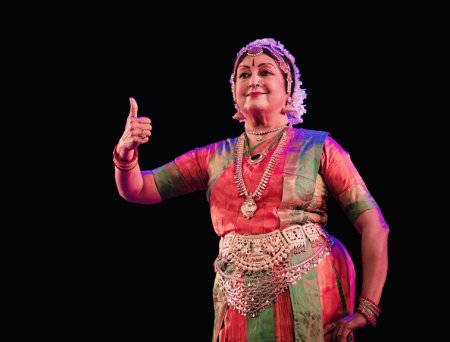 Dr. Padma Subrahmanyam Dr. Padma Subrahmanyam’s Bharatanrityam as usual was ever enchanting. Pushpanjali, Vinayaka stuti displayed her complete command over the technique. But what was the highlight were her sanchari bhavas in Dashavatara. In particular, Vamanavatara left an indelible impression. Bali raja when he was promising the dwarf three steps, the rishi got worried and took form of a bee and blocked the passage from where water can flow. Knowing that it was the rishi in form of a bee blocking the passage, Vamana picked up the blade of a grass and poked into the passage. The rishi’s eye was blinded and with great agony he jumped out and the water flowed from kamandala and Bali gave the promise he would give three steps of the land. The manner in which Padma enacted the agony of rishi jumping out and Vamana taking two strides covering prithvi, akash and then placed his foot for third step on head of Bali was breathtaking and won spontaneous rounds of applause. Another memorable abhinaya number she had selected was a poem of Vallathol which has so far not been performed. The daughter of a ganika, a courtesan, who does not want to continue a life of a prostitute, wishes to commit suicide. But when she listens to the slogans in praise of mother India, she instead of committing suicide opens the door and joins the people for freedom. The end was changed by Padma on a positive note of becoming free than ending life. Young Mahati Kannan, daughter of Padma’s nephew, presented a vachana of Akka Mahadevi choreographed by Padma. Mahati has received training under Padma and with her natural gifts is bound to go places. The musicians gave their customary support to Padma and Mahati. At 70 Padma performs becoming her age and with supreme gift of abhinaya, her admirers are spellbound. Conclave 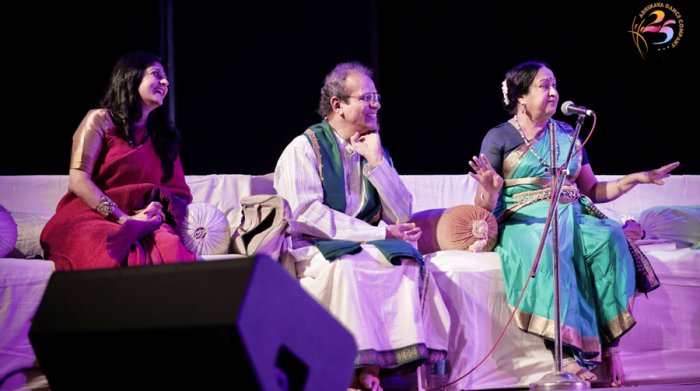 Nirupama Rajendra, Dr. R Ganesh, Dr. Padma Subrahmanyam The conclave on 15th February had two sessions. The morning session was devoted to release of scholarly book Prekshniyam containing Essays on Indian Classical Dance and Theatre of Dr Shatavadhani R Ganesh, adapted into English by Arjun Bharadwaj. His lecture on Natyasastra touching on Natyasastra and box office was highly communicative and accessible to audience as he enunciated the rasa theory elucidating by saying that we are human beings and therefore we relish rasa, which has been compared to Brahmananda Sahodara. Padma Subrahmanyam spoke of abhinaya as a means of communication. Mahati Kannan demonstrated the various ways head movements are employed in dance and how they communicate. Padma gave an example of Krishna ni begane baro showing three states of how a gopi would invite Krishna, how a samanya woman makes eyes at a nayak and how mother Yashoda would call Krishna. Saroj Khan, the popular choreographer for dance in films, explained how with dance movements she plans to communicate and also entertain. A session by film director and cinematographer Rajiv Menon was on how classical Carnatic music was used in films. Well known for his film ‘Sarvam Tala Mayam,’ he chose select excerpts from silent films to talkies and spoke about how the transition took place. Many mythological themes were used which had pan Indian appeal. Talkies divided and created linguistic identity. He gave example of a film in which hero spoke in Tamil and heroine in Telugu! Montages of popular Carnatic musicians in films included M S Subbulakshmi, how national identity was established through cinema, Kamala dancing to national songs et al. He spoke about North Indian influence on South Indian film music. Being a versatile musician, he rendered classical ragas. He gave an example of film ‘Parashakti’ from which even dialogues were sold on record discs and the script writer was Karunanidhi! 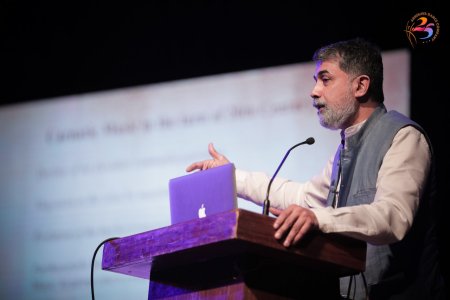 Rajiv Menon He screened an excerpt of a film in which Vyjayantimala’s mother Vasundhara sang and danced. BV Keskar, Minister for Information and Broadcasting, did not like western influence on classical music. Cinema was seen as murky, plagiarized and westernized. In 1951, Keskar banned film music from All India Radio. However, film music captured audiences. Binaca Geet Mala on Radio Ceylon was most popular. The development with orchestra, different tunes, mixing of western tunes created a different genre of film music. And today we have music directors like AR Rahman whose tunes have great popular appeal. Rajiv Menon laced his talk with wit, humour and comments which regaled the audience. His was the best session that the audience loved. I enjoyed it immensely. The sessions on music by Rajkumar Bharati, Praveen D Rao and Pravin Ghorkhindi were noteworthy for experimentations, large orchestra, and different genres of music as in case of Rajkumar Bharati, how he handled music for productions of Apsaras Arts, Singapore, like ‘Angkor Vat’ where there were musicians from Cambodia, Java, Singapore, and he had used live Carnatic music. Praveen D Rao gave history of music he composed for Abhinava Dance Company for past 25 years. Pravin Ghorkhindi also gave examples of how music was composed for seasons. The conclave was educative and entertaining. When dancers celebrate 25 years of their institution, it was appropriate that wonderful moments of creative process were unveiled.  Dr. Sunil Kothari is a dance historian, scholar, author and critic, Padma Shri awardee and fellow, Sangeet Natak Akademi. Dance Critics' Association, New York, has honoured him with Lifetime Achievement award. Post your comments Please provide your name and email id when you use the Anonymous profile in the blog to post a comment. All appropriate comments posted with name and email id in the blog will also be featured in the site. |